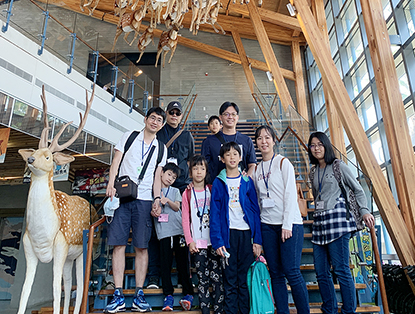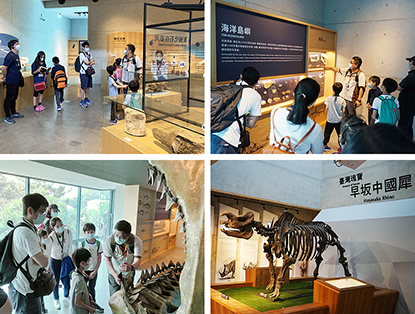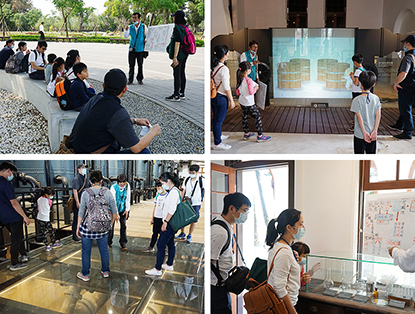Sketch of Archilife Study Tour, March 2021
|
2021年3月份見識之旅縮影  3月份見識之旅活動,於2021年3月27日由呂明澐小姐帶領7位祐生見習生及家長們,進行左鎮化石尋寶暨都市水道現代化探索之旅。出發當日天氣晴朗,見習生們及其家長準時集合並出發。活動開始之初,領隊呂明澐小姐提醒本次活動注意事項及觀察重點,先行建立見習生的背景知識。 3月份見識之旅活動,於2021年3月27日由呂明澐小姐帶領7位祐生見習生及家長們,進行左鎮化石尋寶暨都市水道現代化探索之旅。出發當日天氣晴朗,見習生們及其家長準時集合並出發。活動開始之初,領隊呂明澐小姐提醒本次活動注意事項及觀察重點,先行建立見習生的背景知識。For the study tour of March 27, 2021, Ms. Lu Ming-yun led seven ARF interns and their parents on a trip to discover fossils and the modernization of urban waterworks in Tainan. It was clear and sunny on the day of the tour, and the interns and their parents were on time for the departure. At the start of the day's activities, team leader Ms. Lu Ming-yun reminded everyone about things to note and what to observe, and gave the interns some background knowledge.  本次行程上午前往台南左鎮化石園區參觀,由化石研究人員擔任導覽老師。行程一開始,導覽老師藉由建築模型介紹園區的成立背景及周遭環境,左鎮菜寮溪流域出土許多珍貴的動物化石,並在此發現左鎮人部分頭蓋骨,因而成為化石研究重鎮,近年來政府將資源整合成目前的化石主題園區,將珍貴化石與許多歷史文物收藏於館內,以供大眾參觀。隨後講述化石形成的四大歷程,說明化石是生物在其死亡後,身體尚未完全腐爛前被洪水或火山灰掩埋,經石化作用形成,而在地殼變動下露出地表時,被發現的過程。導覽老師現場亦取出自己在菜寮溪挖掘到的牡蠣殼化石給眾人傳閱,透過雙手觸摸並感受其重量,昔日輕薄銳利的蚵殼成為今日手中厚實溫潤的石頭,見習生們皆驚嘆不已。隨後前往觀看當期特展,透過360度環景投影及海洋動物化石模型,探索魚類如何藉由身體構造的改變逐漸從海洋走上陸地。導覽老師指出,高山上也會發現海洋動物化石,係因原本在海裡的地層受板塊擠壓抬升形成高山,如在台灣高山河床上就發現有貝殼化石。 本次行程上午前往台南左鎮化石園區參觀,由化石研究人員擔任導覽老師。行程一開始,導覽老師藉由建築模型介紹園區的成立背景及周遭環境,左鎮菜寮溪流域出土許多珍貴的動物化石,並在此發現左鎮人部分頭蓋骨,因而成為化石研究重鎮,近年來政府將資源整合成目前的化石主題園區,將珍貴化石與許多歷史文物收藏於館內,以供大眾參觀。隨後講述化石形成的四大歷程,說明化石是生物在其死亡後,身體尚未完全腐爛前被洪水或火山灰掩埋,經石化作用形成,而在地殼變動下露出地表時,被發現的過程。導覽老師現場亦取出自己在菜寮溪挖掘到的牡蠣殼化石給眾人傳閱,透過雙手觸摸並感受其重量,昔日輕薄銳利的蚵殼成為今日手中厚實溫潤的石頭,見習生們皆驚嘆不已。隨後前往觀看當期特展,透過360度環景投影及海洋動物化石模型,探索魚類如何藉由身體構造的改變逐漸從海洋走上陸地。導覽老師指出,高山上也會發現海洋動物化石,係因原本在海裡的地層受板塊擠壓抬升形成高山,如在台灣高山河床上就發現有貝殼化石。The tour began with a visit to Tainan City Zuojhen Fossil Park in the morning. Guided by its fossil researcher, the tour started with an introduction to the background of the fossil park and its surrounding environment through architectural models. Many precious animal fossils have been discovered in the basin of Cailiao River, Zuojhen, even parts of the skull of Zuojhen Man, making it an important site for fossil research. In recent years, the government has integrated all these resources into the fossil park, keeping the precious fossils and historical relics for public viewing. The tour guide went on to describe the formation of fossils, explaining that fossils are formed when dead organisms are buried in flood sediment or volcanic ash before they fully decomposed, and are discovered when they emerge from the earth during tectonic shifts. The tour guide also showed everyone an oyster shell fossil that he dug out from the Cailiao Creek. By touching it with their hands and feeling its weight, the interns were amazed at how a previously light, thin and sharp shell could have turned into a thick, smooth and solid stone. Everyone then proceeded to a special exhibition that was held during that period. Through 360-degree surround view and models of marine fossils, everyone learned about how fishes have changed their body structure to gradually move from sea to the land. The tour guide pointed out that marine fossils can also be found in the mountains because tectonic plates under the sea push together and rise up to the surface. For instance, shell fossils have been discovered in the river beds of Taiwan's mountains.  下午參訪山上花園水道博物館。導覽老師首先即介紹該博物館前身為台南水道,是全台灣保存最完整的水道設施,並透過自製手繪板描述乾淨的民生用水如何從曾文溪汲取水源經過多道程序成為自來水,先行為眾人建立相關概念。隨後進入昔日快濾筒室實際模擬當時的作業方式,導覽老師透過教學影片及讓見習生角色扮演,講述快速過濾雜質的快濾筒運轉模式,簡單解釋如何利用硫酸礬土吸附水中微小雜質,之後再以氯殺菌的過程。見習生亦藉由一旁互動體驗裝置學習相關知識。因水源過濾淨化涉及化學相關領域知識,過程也較複雜不易懂,為此導覽老師十分用心準備教學素材及設計角色扮演遊戲,希望以簡單活潑的方式幫助學習,也讓大家留下深刻印象。至此,本日活動已近尾聲,大家一起合照留念後搭車返程,並期待於下次見識之旅再相見。 下午參訪山上花園水道博物館。導覽老師首先即介紹該博物館前身為台南水道,是全台灣保存最完整的水道設施,並透過自製手繪板描述乾淨的民生用水如何從曾文溪汲取水源經過多道程序成為自來水,先行為眾人建立相關概念。隨後進入昔日快濾筒室實際模擬當時的作業方式,導覽老師透過教學影片及讓見習生角色扮演,講述快速過濾雜質的快濾筒運轉模式,簡單解釋如何利用硫酸礬土吸附水中微小雜質,之後再以氯殺菌的過程。見習生亦藉由一旁互動體驗裝置學習相關知識。因水源過濾淨化涉及化學相關領域知識,過程也較複雜不易懂,為此導覽老師十分用心準備教學素材及設計角色扮演遊戲,希望以簡單活潑的方式幫助學習,也讓大家留下深刻印象。至此,本日活動已近尾聲,大家一起合照留念後搭車返程,並期待於下次見識之旅再相見。In the afternoon, everyone visited the Tainan Shan-Shang Garden and Old Waterworks Museum. The tour guide began by explaining that the museum was formerly the old Tainan watercourse, which is the most well preserved watercourse in Taiwan. Using a hand-drawn board, he also explained how water sourced from Zengwen River goes through many steps to become clean tap water, establishing the fundamental concept for everyone. Next, everyone entered the old quick-filtering room to simulate the actual operating method used in the past. Using an instructional video and role-playing, the tour guide described the quick filtration of impurities, explaining how aluminium sulfate is used to absorb microscopic impurities in the water, and how chlorine is used for sterilization, allowing the interns to learn through interaction and hands-on experience. As water filtration and purification involve the knowledge of chemistry and the process is complex and difficult to understand, the tour guide had carefully prepared teaching materials and designed the role-playing game to facilitate learning in an easy and fun way, leaving a deep impression on everyone. At this point, the day's itinerary came to an end. Everyone took a group photo before heading back and looked forward to the next study tour. |

